
Steve McClure has made the second ascent of Neil Gresham's Olympiad (8b) at Skrinkle Haven, Pembroke. Neil climbed the route in 2012 as an 8b deep water solo, but Steve opted to place gear for a grade of E10 6c.
Steve first looked at the route last year but was hindered by the dreadful conditions that often plague Pembroke. Despite this, he abseiled down the line and immediately realised how difficult it is to work a steep line like this from an ab line. He started a tricky 'down-aid' of the route and saw potential holds but realised the crux of the route would be finding DWS partners, conditions, calm seas and tides - hence why he decided to lead the route.
His ascent comes after a productive few weeks around the UK. In Dovedale, he ticked The Final Round (E8 6c), an E9 6c put up by Tom Randall in 2015, and in Pembroke, he climbed Do You Know Where Your Children Are? (E8 6c) (E8 6c) which was first climbed by James Pearson in 2011.
Just over a week ago, he flashed Dave Birkett's Impact Day (E8 6c) (E8 6c) on Pavey Ark in the Lake District. In his excellent account of the ascent which you can read below, Steve describes how he needed the stars to align for the ascent:
Steve has written about his experience of Olympiad below:
Far below me, I watched as the emerald-green sea drifted gently, the blanket of water rising and falling with my breath. Flat calm, the smooth surface stretched out to a pin-sharp horizon in the distance. The tide mark of dampness on barnacle-covered walls was only a foot or so high, a clear marker of tranquillity; this was perfect conditions for deep water soloing. However, through crystal-clear water, undulating rocky ledges were clearly visible, perhaps down a meter or so. With the tide going out, I'd clearly missed the boat. But I wasn't here for that, I was just here to explore and check out Neil Gresham's awesome DWS Olympiad; to see if it could be possible. For this weekend the tides were all wrong, and anyway, it was April, it would be bloody freezing; for someone as nesh as me, I'm not sure hitting that water would be preferable to a ground fall. When would it be right? I was in Pembroke twice last year and conditions were so humid as to make every route desperate, and when they perked up, so did the swell, with crashing waves rendering DWS pretty much the same as soloing for all but the most aquatic. It seemed the timing was everything, probably more than being capable of the climb!
And that's when the spark appeared as I stared down into the water and the tide slid peacefully away, I'd not even considered it for a moment, but now, perhaps it could be something: to lead Olympiad on traditional gear.
Neil climbed Olympiad in 2012. It took quite a bit of effort, including multiple visits, some of which were rendered useless due to conditions of the rock or sea or both. There were many falls, many soggy chalk bags. But he persevered in true Gresham style to give a gem of a route, probably the hardest piece of rock climbing in Pembroke. It's a perfect DWS, hard climbing right off the deck (water, or boat!), which stays relentlessly hard up the brutally steep 40-degree overhanging wall. An all-out lunge to jugs at the end of the hard stuff is a fitting end, and at the relatively low height of about 10m makes it totally amenable to go all-out even for landlubbers like myself. The perfect DWS, though only perfect once you'd actually started climbing!
Despite it being at least 8b, the crux became overcoming the 'faff factor'. With no walk or traverse in, the route begins with an abseil straight into the sea and a swim into a dark hole where it's possible to suppress the shivering and extract kit from a hopefully functioning dry-bag. From the hole, a scuttle sideways gets you on the route before plopping off back into the freezing water, with just a couple of goes in a relatively small time window. The water is deep, but not that deep, maybe three to four meters, and ironically can get too deep on a springtide with all the starting holds underwater! In the end, Neil solved the crux by abseiling into an inflatable dinghy, though without doubt, it was his determination that kept his powder dry on the successful ascent.
So despite the quality, it's not a huge surprise Olympiad has held on for nine years for a second ascent, despite efforts from some very strong contenders. I knew all of this but was still psyched to get involved. I even have a dinghy! But I could feel the challenge of a trad lead starting to grow. Not a DWS, very different: the same route but with altered challenges. This type of hybrid route style is actually really popular in Pembroke, with literally hundreds of routes that can go in either style due to the huge tidal swing. It's yet another attraction marking Pembroke out as really unique and special.
Despite being keen to get on Olympiad it took until last year for a first look. Peering down I swear someone had thrown buckets of oil over the entire wall; a gopping blackness that only British sea cliffs on a windless, humid summers day can achieve. But I was there, so I had to have a look. At one point in time, I'd pondered going for a ground-up style, the purist approach, though tales of top climbers repeatedly falling off the first moves put me off. Sometimes you have to know where your limits are (physically, mentally, and how long you've got left to live!). Abseiling down I was immediately introduced to a whole extra faff factor; clipping into a thread and lowering less than a meter I was instantly out of reach from the wall and had to jug back up again. Thus began a desperate down-aid / intensive shoulder and core session, with dodgy wires and cams pinging out of greasy parallel cracks; the bullet hard, smooth limestone offering nothing in the way of friction. It took me an age to get the start, whereupon I immediately turned around and came back up again. On the way, I observed some potential holds, but to be honest I just wanted to get the hell out of there before I collapsed. This experience should have put me off, but undeterred I was back this April, in far better conditions, and within a couple of hours sat on a Petzl Grigri had some idea of the moves. I was already hooked. I wanted to get involved, ideally without having to wait for the frustratingly infrequent combination of tides, calm seas, good conditions, willing DWS partners, free time and motivation to drive 5 hours from Sheffield.
A trad lead seemed the answer, but to be honest, the entire concept was based on the bomber wire slot miraculously positioned in the middle of the wall. There was also plenty of other gear too, essential for the downward aid excursion, though most of it was dodgy at best and probably impossible to place on lead. This is why DWS is so good; no need to mess around placing kit, no need to stretch out to place fiddly wires and then shake out the pump as you try to reposition your badly positioned half in – half out number 3. With DWS you just set off and blast it non-stop till you either hit the top or hit the water. As a DWS, Olympiad had a high faff factor, but at least it was known and tested. As a trad lead, there was still a lot up in the air! Like, I didn't even know if it was dry at the bottom for more than a couple of minutes!
At the end of May, there was a combination of good weather, a couple of free days, a partner with local climber Ed Morris, and, ideally for my purposes, low tide between midday and 1pm. This was another exploration. The first day we arrived late, the tide well in and the swell crashing and booming and sending spray upwards as if to pull me back into its grasp. I checked the moves again; still the same, really hard, lots of them, but, on a Grigri and climbed in 30 sections, it seemed possible! Second day dawned with a clear blue sky and warm sun. Another essential ingredient as the Olympiad wall catches the rays till about 11 am, drying off any offending sea slime. We had the full run of the day.
Dropping in everything looked new, and unclipping from the abseil and stepping back the wall looked entirely different, not least of which is the starting holds were now about six meters above a very hard landing. As well as that, the miraculous wire halfway up the wall, was just that, about halfway up, with not much margin of error and a likely serious level of heart flutter when about to go for that final lunge-to-jug. Just thinking about it was almost enough to ditch the idea there and then. At least the entry to the route was protectable with a soggy traverse in from the side and a cam in a crack full of sea creatures. I jugged out, grappling with the moves again, only this time everything felt harder; hands sliding and feet slipping all over the place. It felt warm and humid, there were black clouds above and no wind. Or was it me wanting it to be too hard, too hard to try?
The route proper begins from a good rail, ideally two meters above the water, or in my case, six meters above the ground. A decent wire by the rail, and another higher up but very hard to place protects the V9 section leading up to the most massive but hard to use hold you'll ever find, an upside down slot with an internal Teflon coating. Somehow a kneebar is inserted, which is actually quite good when it's in, though for some reason I just couldn't make it work. The sequence of moves around the slot is one of those sequences that doesn't have a sequence. Every attempt is a wrestling match, and every match is different, and when it eventually works you don't remember what you did and can't repeat it again. Over and over I fell out of it; "FFS, there is no way I'm gonna get through this, it's just so ridiculously awkward."
If one does manage to engage knee, then the miraculous wire is placed, along with a cam or two to keep it company, just in case, because from there I'm going a long way, and will probably fall off. A quick chalk up and then an incredible 12 hand-move sequence; powerful and burly with big moves on side-pulls and awkward finger jams leading to a decent hold and distant view of the last gear. And the gods shined on me again with another slot, a decent wire, though care was needed as it goes in awkward and will fall out the bottom unless you make it good. And you want it good, as the crux is still to come; a boulder problem sequence as good as any creation on the comp wall of The Works. The finishing jug almost seems too good to be true, like someone must have put it there! The last five meters or so is relatively easy, maybe E3, with a bomber thread, you'll not drop that section.
So I'm back on top, and then abseiling down again, though this time vertically with the rack on my harness and nothing left in the route save a skinny cord tied around a chicken head right at the start. I want to try but I kind of don't, and if it wasn't for Dave Petts who'd come along with his video kit I probably wouldn't bother, but feel as though I need to at least give him something to turn his camera on for. The tide has turned too, it's a shorter window than we thought, one shot only! If anything, it will be interesting to see what it's like to get to the rail. I'm setting off with perhaps the lowest expectations I've ever had, and that's saying something from the master of reverse psychology.
Sliding sideways out of the cave the cams don't seem to fit anymore but it's only a few moves to the rail; press on. And here I am now at the 'official' start, and in goes the wire to mark the starting line. The first hard move, a V7 to place a DMM blue offset, pretty crucial for this first section, but I've bumbled it, and it's jammed wrongly on a knobble. Is it in enough? Can't see now, I'll look as I pass it. And now I'm committed, with hard slaps and reaches and a couple of foot moves that weren't part of the plan. The blue wire later fell out by itself! Now I'm in the slot, grappling with the kneebar, shoving in my leg and pressing down so hard my calf might explode. In goes the wire and cam; they still look bomber, even though I'm on lead. So often the 'bomber' placements look a tad different on the sharp end. I squeeze more into the knee and allow myself to step out of the zone. Wow. I'm here! That's a genuine surprise. Things feel different, there is sunshine again sparkling off the lapping pools below and a breeze. Conditions are notably better. Maybe this is actually a proper go, not just a 'look'. The logistics flash through should I fall; I'll end up hanging on the gear and be lowered to the ground. Then I'll have to jug back up to the top of the crag, collect a bunch of rack, down-aid the entire route to the start placing a load of kit, then jug all the way back out again taking back out the gear. Then abseil in, and, thoroughly exhausted, immediately set off on another go before the tide comes in to ruin my relationship with Ed before it's even really started.
Shaking that from my mind seems harder than shaking out the pump from my arms, but I'm away and now absorbed by the difficulty; moving in sport mode, trusting that gear like a bolt. And those moves are just so good! The next decent hold is in my hand and my heart rate is up. Which side of my harness is the wire on? No, the other side. And where is the long draw to extend it? Oh, I've forgotten it, hope there isn't too much drag. Clearly, two ropes would have been better, though I've already used two ropes at the traversing start and had to ditch one. Aarrgh, too many things to think about! The wire has gone in badly again but I don't yank it this time, I rattle it in and make sure it's right. Wow, and now I'm here, actually, this IS a proper go!
Later on, discussing with those on the ground, they all clearly noted three different and distinct stages in my climbing: the first part to the kneebar was shaky and nervous, pessimistic even. The second to the distant wire was focused, determined and streamlined. But the third was like engaging an unknown 6th gear! There was just no way I was falling off; that extra 6th gear only available with the prospect of hours of knackering aid climbing and the knowledge that the next available opportunity could be anywhere between a few months and a decade away!
Hitting the jug was awesome, though not quite the image I'd had when visualizing the route lying in my sleeping bag the night before; of a dynamic lunge to just catch the hold, feet flying out backwards and huge air beneath. That move is better suited to a good few meters of water below as opposed to a wire way out to the side.
I'll save it for when I go back and solo it above water, it's still the plan. Just need the stars to align. Anyone for both styles in a day?
Olympiad, 8b, S1, F3, DWS, Neil Gresham, 2012
Olympiad, E10 6c, F3, trad lead, Steve McClure, 2021
(note, F= faff factor, graded 1-3, which all adds to the fun really)



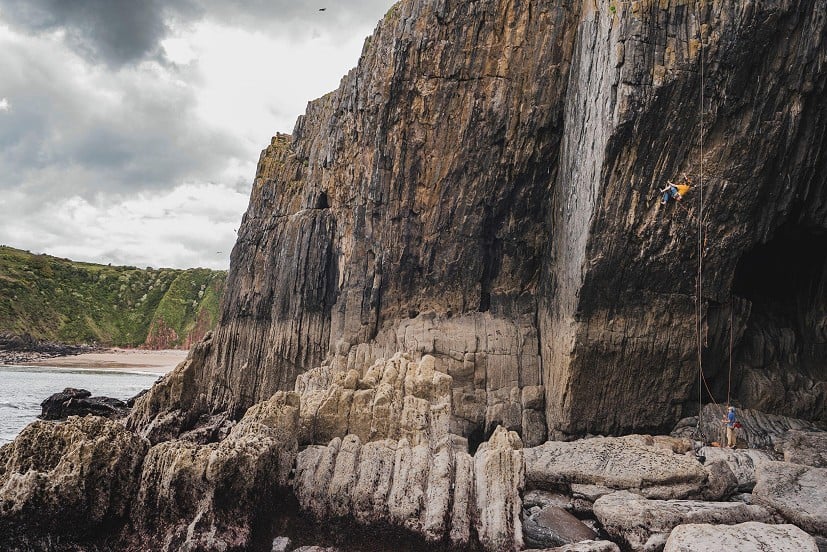


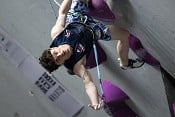
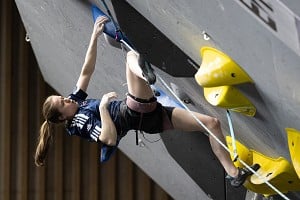
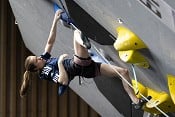
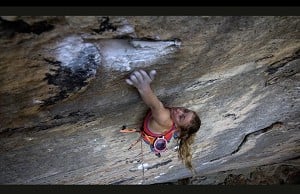
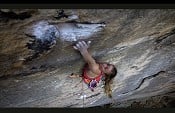


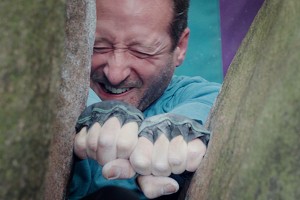
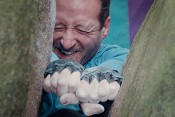




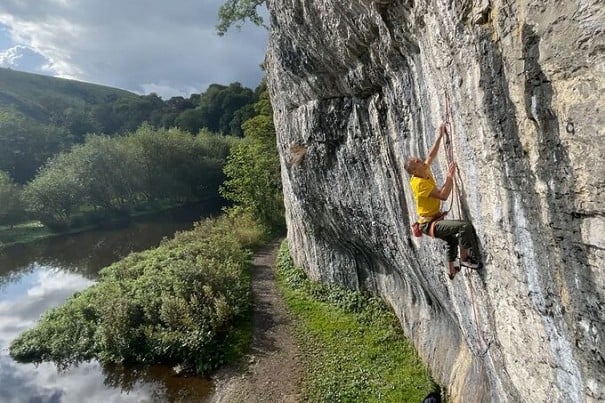
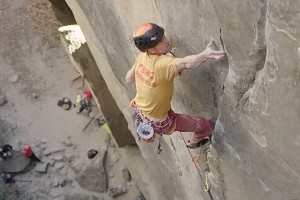
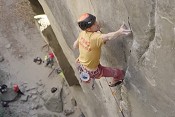
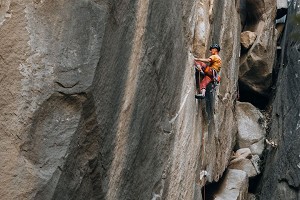
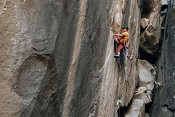
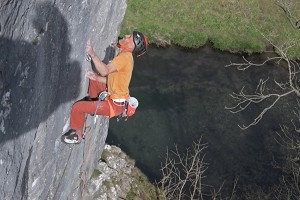
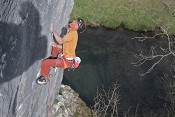
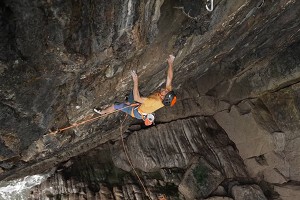
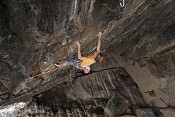


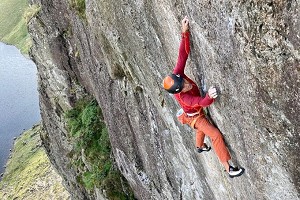
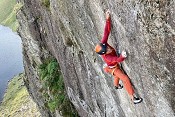
Comments
What's the point bothering with the boat when he knows he's probably going to fall in several times anyway?
Because who doesn't want to see a grown man in a child's inflatable boat
Someone here rowed the 24-odd miles around the island in one at the weekend.
https://guernseypress.com/news/2021/06/01/round-island-row-raises-more-than-3k/
An excellent account. Great to have this repeated and suggested as the hardest piece of rock climbing in Pembroke! Well done Neil (and Steve)
Great read. I can also see the F grades for faff really catching on.